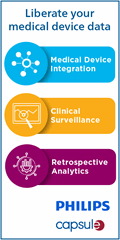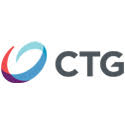Monday Morning Update 9/24/07
From Dr. Lisa Cuddy: “Re: Philips entering the European HIS market. A likely target may be Agfa. No revenue growth, no big sales, but solid installed base. There are rumors about divesting the Agfa healthcare group and potential bidders are GE, Philips and 3M.”
From The PACS Designer: “Re: Oracle 11g Advanced Compression. The subject of compression stirs a lot of debate when discussing digital image files and what degree of compression to use without destroying the technical composition of the reviewed file. Oracle isn’t addressing image compression in 11g, but they are addressing compression techniques to speed overall system performance, such as cache memory and I/O query/retrieve from your database archive. Oracle 11g has the capability to do table compression to more efficiently use storage resources and, at the same time, improve overall access time to satisfy the ever-increasing demand for faster results from large databases. Another new feature is to store frequent transaction requests in cache memory so that the next request is processed sooner by requiring less information from the archive.”
From Art Vandelay: “Re: Joel Diamond of dbMotion interview. How is your product different from 3M’s Clinical Data Repository with configurable workstation, health data dictionary, and alert writer?” Joel was gracious to provide a response. “First of all, let me congratulate you for your fantastic HIStalk interview. I wanted to respond to your ever-insightful commentary and question. While we don’t comment on specific competitors in the public domain, I would like to answer your question in a general sense by pointing out that the dbMotion product is unique in that it is one of the only solutions on the market today which addresses the interoperability problem in an end-to-end manner. Other products can provide partial solutions, such as a centralized patient view (portal), messaging, or result delivery. dbMotion, on the other hand, provides a complete platform that doesn’t stop there — it goes a few steps further by enabling its customers to maximally leverage their existing IT infrastructure to address current and future needs. Our SOA architecture and sole focus on interoperability allows us to address all aspects of this complicated arena, including security, vocabularies, and semantic knowledge. We often find that alternative solutions involve assembling together a set of tools which are normally sold and thus often operated independently. Even then, most companies still need to add components from external vendors to provide necessary functionality. We also pride ourselves in the fact that our solution is pragmatic in that it was built to serve imperfect environments– not just those that have ideal interfaces and harmonization of technologies.”
From Dave Unger: “Re: Bronx-Lebanon. I saw ECLP announced the deal. Any idea of deal size?” You heard it here first, of course, from Inside View, although In the Know was wrong just a few weeks earlier when he/she called Cerner as the winner. I haven’t heard the contract size so far, but I bet I will.
From EMR Guy: “Re: CCHIT. I heard the 2007 CCHIT certification process was much more difficult than previous years, and that one of the reasons why so few vendors entered the certification process was because it was so difficult. In other words, that many vendors could ‘get away’ with promoting their 2006 certification, leaving the impression that they were recently certified.” For that or other reason, 2007 certificants are in far fewer supply, with many vendors still displaying 2006 stickers (or none at all). Some would say that’s what CCHIT intended – make it easy to get that first stamp of approval, then rely on competitive pressure to move vendors up the ladder to meet increasingly tough standards. It’s interesting that newer, smaller, cheaper vendors have already nailed the 2007 standards, while older, larger, more expensive ones haven’t. The guard is indeed changing.
From Bud Kruger: “Re: Quovadx. Likely based on the Latin quo vadis, which means ‘where are you going?'” Good name for an interface engine company like Quovadx if so, although their product name Cloverleaf is better.
From Joe Seluchi: “Re: Eclipsys. Are you hearing anything about Sunrise XA performance or how the early adopters of Sunrise Pharmacy are doing?” I’ve spoken to one Sunrise user and one Sunrise Pharmacy user (not the same hospital). The first said they were having performance issues, but didn’t elaborate. The second seemed pretty happy with pharmacy, but also didn’t elaborate. First person reports are welcome.
From Steven McCroskey: “Re: Rep. Murtha. John Murtha of PA, the guy who brings home all the bacon to the Johnstown area, including government money for HIT research through a Conemaugh Health System spin-off, is named one of the most corrupt in Congress by Citizens for Responsibility and Ethics Washington.” Murtha was already identified as having more earmark projects (i.e., wasteful pork barrel projects) for his home district than anyone else in Congress. He moved up from “dishonorable member” to “corrupt” after charging across the House floor to threaten a fellow Congressman for questioning a $23 million Murtha pet project, the National Drug Intelligence Center, to be located in the high tech mecca of Johnstown, PA. I knew about Conemaugh subsidiary InforMedx Group, which was doing some kind of simple research for the DoD using grant money (i.e., your federal tax dollars) that Murtha arranged. One company employee, I notice, is named Murtha. Probably a coincidence.
From D. C. Simonton: “Re: Epic. Epic reported at their annual conference that they’re planning to move to a web-based client from their current Windows/Citrix approach. They claim it will take them 5-7 years to complete the transition!” Appreciated, unverified, confirmation welcome.
From Ted Striker: “Re: QuadraMed. San Bernardino layoffs rumored – several project managers, developers, customer support people, managers, and a director.” Unverified.
Want to help kick some crippling disease ass? Click here and watch the four-minute “Augie’s Quest” video on ALS. For your time, Allscripts CEO Glen Tullman will donate $1 to ALS research, along with another donor who will do the same. Your four minutes thus contributes $2, each and every time you watch the video. Pass it on – it’s Glen’s money going toward a good cause.
I got a fun e-mail from Danny Sands of Cisco after our interview. I’d told him that, based on the experience of others I’ve interviewed, he’d hear from lots of folks quickly, and likely some who had been out of touch for awhile. He e-mailed today: “I was on the road and finally had time to read the interview. Thanks. Based on e-mails I received, I am impressed with how many read HIStalk. Someone I hadn’t seen in years happen to run into my mother and told her about it!” That’s cool. Made my day.
I haven’t recently mentioned my weekly editorials for Inside Healthcare Computing, a long-time HIStalk sponsor and, as I’ve said before, the only HIT (or IT, for that matter) publication that I’ve ever paid to receive. Good news, opinion, and fact-finding. The only place I know of that you can get a detailed description (pricing and terms) of what hospitals paid for Cerner, McKesson, Eclipsys, etc., nimbly pried from reluctant fingers using state and federal open records laws for journalists. Anyway, what I’ve opined recently on their platform:
- Healthcare Software: No, You May NOT Have It Your Way
- The HIT “Trendulum” Starts its Swing Back to Administrative Systems
- Private Investors Will Create Competitive Newcomers
- Google Health: Does Anyone Still Care?
Several folks responded to the “Judy in a wedding dress and mock ceremony with new customers” rumor. Fact: the Wedding March is played over Epic’s PA system when someone signs. That’s it. The point missed by those who e-mailed me to decry this as a ridiculous rumor: Epic’s so quirky that non-employees didn’t bat an eyelash at the idea. That’s the trouble with eccentricity – it isn’t always selective. (Say, maybe I just coined a new GE product name – Eccentricity. Or, what you could call a deinstall: Ex-Centricity). And as one reader offers, “Epic sees customer relationships as marriages. But, as Phillips found out, Epic is usually pretty good at writing pre-nups as well.”
A couple of new Picis deals: Mercy Medical Center of Baltimore chooses perioperative automation and Kennedy Memorial (NJ) goes with ED PulseCheck.
Killer IPO: athenahealth. Shares were priced at $18 (above the expected $14-16 range), but demand pushed the IPO-price to over $35, a quick double and the best first-day gain of 2007. Great news, unless you were an insider and noticed that your big-name underwriters obviously set the open too low and let early buyers take the profits. In their defense, the company is losing money with $80 million in revenue, so maybe the unexpected share demand was irrational. Jonathan Bush has $25 million worth.
Cerner co-founder Cliff Illig on entrepreneurship: “Impatience is a virtue. Have a constant sense of urgency.” The article included a tidbit I didn’t know: the founders renamed the original Paterson, Gorup, Illig and Associates to Cerner, which they took from the Latin cernere, meaning ‘to sift or understand’. Cliff again: “We had a list of things we knew something about, a list of things we didn’t know anything about. One of the things we didn’t know anything about was health care.” And this statement, which some would say still reflects reality: “And to us it always seemed like if you were going to start something you needed to go sell something. So very early on, we went and sold a lab system that didn’t exist.” Good article, good thoughts.
Seton Family Hospitals (TX) outsources infrastructure management to Dell. Seems odd, although cynics might point out that one of Seton’s hospitals is Dell Children’s Medical Center, named for the Michael & Susan Dell Foundation that paid for it. Probably a coincidence.
Here’s the press release announcing the November 5-6 conference I mentioned in a text ad to your right. An executive-level HIStalk reader has already let me know he’ll be attending, so I hope to get a report. The speaker lineup is “sick” (I heard that word used by a college student at a football game this weekend and it apparently has a superbly positive connotation, so I’ll throw it out there as a hip nod to young readers not likely to be attending a C-level conference like this anyway). HIStalk is a media sponsor (we swap ads, in other words). I wouldn’t have done it if the agenda wasn’t strong.
I tried to get an update from Kim Pederson after Allina’s Davies win, but the e-mail address I have isn’t working. A couple of readers asked what she was doing now, but it looks like I won’t be finding out after all.
Welcome to new HIStalk Gold Sponsor Premise of Farmington, CT. The company’s products deal with the urgent hospital issues of patient throughput and business analytics. Products: Bed Management Dashboard, BedXPress Dashboard, Transport Dashboard, Executive Dashboard, and Asset Management Dashhboard. Great case studies and testimonials are on the site. I mentioned a couple of weeks ago that the company doubled its customer base in the last year and had a 100% “would buy again” customer ranking from KLAS. I’m really interested in products like these (having worked on a throughput project in the past), so I hope to interview CEO Eric Rosow about best practices. I don’t know of any hospital that doesn’t have all these problems. Welcome and thanks to Premise for supporting HIStalk and its readers.
Epic’s user group meeting is over. Report, anyone? A Judy quote to users on the $150 million Phase I campus cost: “We try to be extremely careful with your money. (But) sometimes, it’s counter intuitive [because of private office productivity gains] … In five years, the buildings are paid for. The buildings, parking, artwork, everything. In five years, we’re rent-free.” Also mentioned: a PHR project code named Lucy, Epic’s first international customer in Netherlands (home of Philips), and the company’s 2006 revenue of $370 million.
Speaking of Epic, Fletcher Allen Health Care wants to spend $57 million on Epic. Ironic: IDX founder Rich Tarrant is a big wheel there, although he’s downplayed his influence after some of its management went to jail over lying to regulators about construction costs.
Misys says revenue was up, although healthcare’s only mention is to once again label it as underperforming and losing ground with a 2% drop in revenue.
For the ten people who still care, Leapfrog announces its CPOE-centric top hospitals. Even Leapfrog says only 10% have implemented CPOE, which is a testament to its lack of clout. If the CPOE pioneers weren’t coming back with arrows in their backs, Leapfrog wouldn’t have to arm-twist.
MedAvant will provide claims connectivity with Aetna.
Siemens gets a Soarian sale in Germany.
The federal government awards $4 billion in CMS IT contracts to the same vendors it always chooses, although none them are in Johnstown, PA.
Inga’s Update
Skeptic posted a note that was critical of the many excesses at HIMSS. Skeptic’s opinion was that all those big costs ultimately damage healthcare. “It’s never made sense to me,” Skeptic says.
While I agree that there may be too many wasted dollars being spent at HIMSS (and other shows), I am not convinced it is all money wasted (though it goes without saying that a far better use of a company’s marketing dollar would to be an HIStalk sponsor, but I digress …) Here are some reasons I believe a vendor can justify an “investment” in HIMSS sponsorships, exhibits, and the rest:
- The least expensive booth is $2,700. Last year over 24,000 folks attended HIMSS. There are many, many smaller shows out there that charge a similar amount and have only a few hundred attendees. Less than $9 a body is pretty cheap. (Yes, I do realize there are additional costs above the booth rental.)
- The exhibit fees subsidize the cost of the conference. The attendance fees are already high – how much higher would fees be without the sponsorships? If the fees were significantly higher, would attendance be affected? I think so.
- Last year there were over 900 vendors. Sometimes it takes more than free pens to differentiate yourself from the pack and attract people your way. Is it necessary to host big extravagant parties? Perhaps not necessary, but it can make some sense when you have so many clients and prospects all in one place at one time with nothing better to do than go back to a hotel room and order room service.
I suppose an argument could be made that there should be rules restricting vendors from giving away any items worth more than $5 and not allowing complimentary espresso or cocktails (sounds boring). And, maybe it doesn’t all have to “make sense.” If some people have moral objections to the excesses of some vendors, it is their right not to do business with them. I think generally people are smart enough not to be swayed by big marketing dollars when it comes down to making the most important business decisions. If the vendors want to spend big money, then all the more fun for the masses. (I just want to make sure I get an invite to some of the really good parties).
A reader forwarded me a note about a new website being launched, www.medziva.com. It’s still in its early stages, but it appears it will be a site where consumers can inquire about particular labs and lab tests. In terms of addressing the growing trends of consumer-driven healthcare I think the concept is good. I suppose sites such as WebMD provide information about different types of tests or recommended tests for particular diagnoses, but, this site will also allow discussion of the benefits of the labs themselves. Will this be a trend we see more of?
eClinicalWorks has opened a new office in the Big Apple. In April, eCW signed a $19.8 million deal with the NYC Department of Health and Mental Hygiene to provide EMR/PM to 1,300 physicians. eCW will have about 30 employees initially in the new facilities in order to better manage the NYC project.
ACS announces the promotion of Kevin Kyser to CFO. Kyser had previously served as the VP of Finance. He replaces John Rexford, who will remain an Executive VP over key corporate development initiatives, including mergers and acquisitions.























































































Would have liked to have seen more about Expanse here. Would like to see more about it on this site…